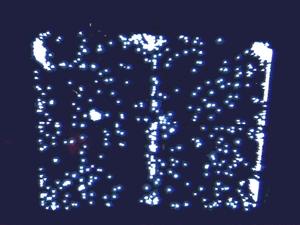GEM High Voltage stability
While GEMs have been shown to be able to work reliably, it is essential in the development of a new GEM-based readout structure to study its long term high voltage stability. The TPC GEM modules have been shown to work stable during a two week period of a testbeam. The current step is to study their long term stability. This includes also the study of the nature of discharges and their properties. Also, why some discharges can be destructive –meaning they cause a permanent resistive connection between both sides of the GEM foil– and other leave the GEM foil unharmed is being studied.
In part of these studies, GEM foils were operated under extreme condictions, i.e. very high voltages well over the normal working point, to provoke many discharges in a reasonable time. The goal is to understand discharge processes better and develop means to minimize their occurance and the probability for destructive discharges. In the end, the HV scheme of the readout module will be tested over a long period of time under normal working conditions to investigate its suitability for a large scale experiment.
The nature of these oscillations is given by the electromagnetic wave that is created by a fast moving charge through a discharge channel.
Discharge topology
Accumulations of many discharges allow us to find and correct "weak" spots.Figure 1a: Overlay of 10,000 discharges. We can see a concentration of discharges at a certain area.
Voltage oscillations and multiple discharges
A detailed investigation of the GEM HV behavior in the first couple of hundred nanoseconds after a discharge allowed us to see correlations in triggering one discharge by another.Figure 2: We can see voltage oscillations on the common GEM side from three sequential discharges within ~100ns.
The nature of these oscillations is given by the electromagnetic wave that is created by a fast moving charge through a discharge channel.





